R Aquarii (R Aqr) is a symbiotic star system located approximately 711 light-years away in the zodiac constellation Aquarius. At its brightest, it shines at magnitude 5.2 and is faintly visible to the unaided eye. At its faintest, it has an apparent magnitude of 12.4 and can be spotted in small telescopes. The R Aquarii system is one of the closest symbiotic stars to the Sun.
Star system
R Aquarii is composed of a red giant of the spectral type M5e-M8.5e and a dim white dwarf. The two components have an orbital period of 15,943 ± 471 days (about 44 years). Their angular separation varies between 0.071 and 0.084 arcseconds, corresponding to a physical distance of 14.2 to 16.8 astronomical units (AU).
The two components form a symbiotic binary star, an interacting binary system where material expelled from the cool, evolved giant star falls to the hot white dwarf companion. As a result, an accretion disk is formed which eventually leads to the ejection of bipolar jets. As the bipolar collimated outflows interact with the circumstellar envelope of the giant star, they produce bipolar structures similar to those seen in planetary nebulae. The nebula around R Aquarii is about 2 arcminutes in size.
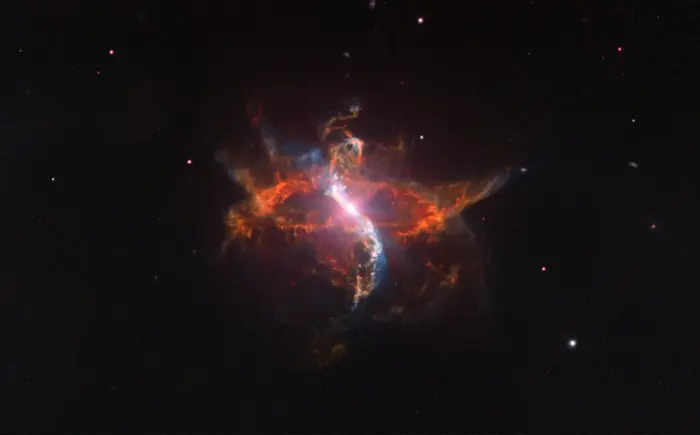
R Aquarii captured by ESO’s Very Large Telescope (VLT), image credit: ESO (CC BY 4.0)
The primary component, R Aquarii A, has a mass of 1 – 1.5 solar masses and has expanded to a size of 430 solar radii. With an effective temperature of 2,800 K, the cool red giant star is 4,780 times more luminous than the Sun.
The white dwarf companion packs a mass of 0.6 – 1 solar mass into a radius at least that of the Sun. It has a surface temperature of 60,000 K and a luminosity of 5 to 20 Suns.
The red giant is classified as a Mira-type variable. Its brightness varies by a factor of several hundred with a period slightly longer than a year. Like Omicron Ceti (Mira) in the constellation Cetus, R Aquarii A is an evolved giant star that varies in brightness due to pulsations. It pulsates with a period of 388 days, but the pulsations are not entirely regular.
The primary component is losing mass at a rate between 10-6 and 10-5 M☉yr-1.
Stars like Mira and R Aqr are giants on the asymptotic giant branch (AGB), a late stage in their life cycles, that will eject their outer envelopes to form planetary nebulae within the next few million years.
The R Aquarii system is classified as a Z Andromedae variable. Z Andromedae stars are symbiotic binary systems composed of a red giant and an accreting white dwarf. Like the class prototype Z Andromedae in the constellation Andromeda, these star systems show irregular brightness variations due to nova-like outbursts.
In 2024, new images obtained with the Wide Field Camera 3 (WFC3) on the Hubble Space Telescope (HST) revealed new details of the R Aquarii star system and the surrounding nebula.
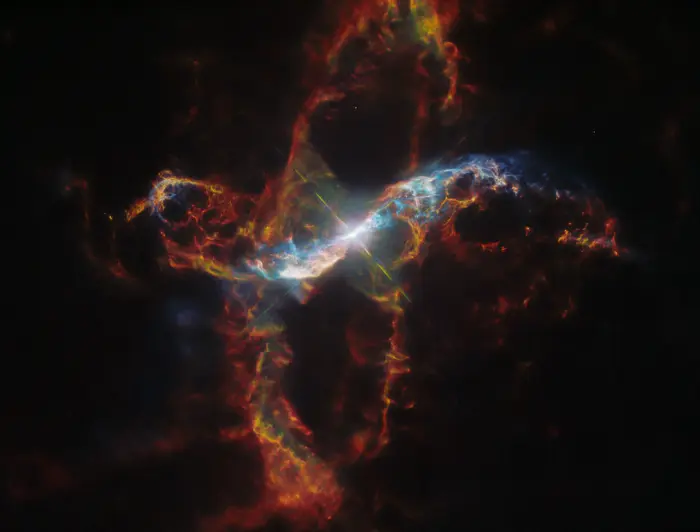
NASA’s Hubble Space Telescope has provided a dramatic and colorful close-up look at one of the most rambunctious stars in our galaxy, weaving a huge spiral pattern among the stars. Located approximately 700 light-years away, a binary star system called R Aquarii undergoes dramatic eruptions that expel huge filaments of glowing gas. The twisted stellar outflows make the region look like a lawn sprinkler gone berserk. This dramatically demonstrates how the universe redistributes the products of nuclear energy that form deep inside stars and jet back into space. R Aquarii belongs to a class of double stars called symbiotic stars. The primary star is an aging red giant and its companion is a compact burned-out star known as a white dwarf. The red giant primary star is classified as a Mira variable that is over 400 times larger than our Sun. The bloated monster star pulsates, changes temperature, and varies in brightness by a factor of 750 times over a roughly 390-day period. At its peak the star is blinding at nearly 5,000 times our Sun’s brightness. When the white dwarf star swings closest to the red giant along its 44-year orbital period, it gravitationally siphons off hydrogen gas. This material accumulates on the dwarf star’s surface until it undergoes spontaneous nuclear fusion, causing a huge eruption. After the outburst, the fueling cycle begins again. This outburst ejects geyser-like filaments shooting out from the core, forming weird loops and trails as the plasma emerges in streamers. The plasma is twisted by the force of the outburst and channeled upwards and outwards by strong magnetic fields. The outflow appears to bend back on itself into a spiral pattern. The plasma is shooting into space over 1 million miles per hour – fast enough to travel from Earth to the Moon in 15 minutes! The filaments are glowing in visible light because they are energized by blistering radiation from the stellar duo. Hubble first observed the star in 1990. R Aquarii was resolved into two very bright stars separated by about 1.6 billion miles. The binary star dims and brightens due to strong pulsations in the red giant star. The scale of the event is extraordinary even in astronomical terms. Space-blasted material can be traced out to at least 248 billion miles from the stars, or 24 times our solar system’s diameter. Images like these and more from Hubble are expected to revolutionize our ideas about such unique stellar “volcanoes” as R Aquarii. Image credit: NASA, ESA, Matthias Stute, Margarita Karovska , Davide De Martin (ESA/Hubble), Mahdi Zamani (ESA/Hubble) (PD)
Nebula
The R Aquarii system is surrounded by a complex nebula formed of material expelled from the white dwarf. The white dwarf accretes material from its more massive companion and occasionally ejects some of it. The material forms loops of nebulosity around the star system. The nebula is catalogued as Cederblad 211.
Even though it reached the end of its life a while ago, the white dwarf is periodically reactivated by the fresh material pulled from the red giant when the two stars are the closest during their 44-year orbital period. As the white dwarf gravitationally pulls hydrogen gas from the red giant, the material accumulates on the surface of the white dwarf until the stellar remnant experiences a sudden burst of nuclear burning. As the energy is released, the outer layers of the star are ejected at speeds of up to several hundred thousand kilometres per hour. The expelled material can be detected out to at least 2,500 astronomical units (Earth – Sun distances) from the core of R Aquarii. After the outburst, the cycle begins again.
The outer nebula may be the remnant of an outburst recorded by Japanese astronomers in 930 CE.
In the 1970s, astronomers found a new feature of nebulosity near the star on photographic plates obtained with the 3-metre telescope at Lick Observatory. The prominent curved jet or spike appears as a protrusion from the nebula’s central star.
In the 1980s, astronomers proposed that the jet was the result of too much mass transferred from the cool giant star to the hot white dwarf in a highly elliptical orbit.
Observations with the Faint Object Camera on the Hubble Space Telescope (HST) in the 1990s provided astronomers with new insights into the mechanism that produces the eruptions.
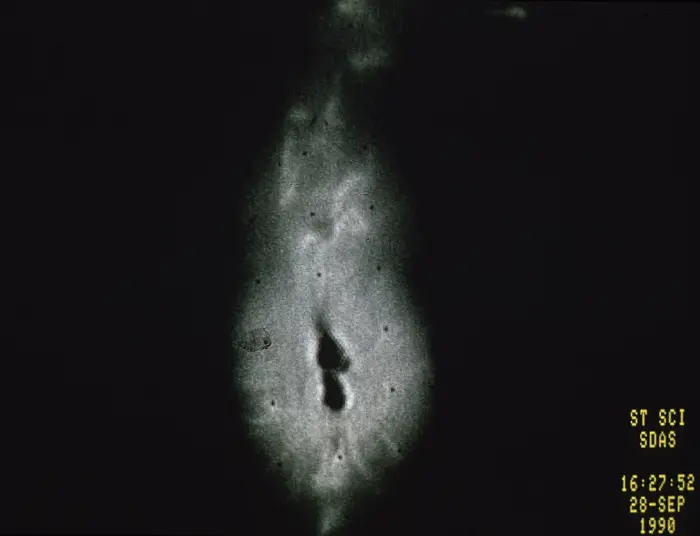
This is the first picture taken by HST of a recent nova, the star system R-Aquarii. The two dark knots at the center of the image probably contain the binary star system itself, which consists of a red giant and white dwarf star. The knots are dark due to saturation effects produced by the FOC detector when it observes very bright objects. The filamentary features emanating from the core are hot gas (plasma) that has been ejected at high speeds from the binary pair. The plasma emerges as a 400 billion kilometer-long geyser which is twisted by the force of the outburst and channeled upwards and outwards by strong magnetic fields. The flowing material appears to bend back on itself in a spiral pattern, perhaps due to obstruction in the path. Image credit: NASA and ESA (Hubble Space Telescope), 1990 (PD)
Astronomers have detected a highly collimated bipolar jet down to at least 15 astronomical units of the red giant. They proposed that the source, speed and direction of the jet were closely connected to the condition of the stellar wind. The interaction between the two components also plays a part in the jet formation mechanism.
The jet is clearly visible in the ultraviolet band. The source of the jet is within the binary orbit of the two components. The jet flows from the system in a narrow stream up to 15 AU wide for about 50 AU, where it excites a dense clump and makes it glow as an emission nebula.
The clump is the brightest object in the centre of R Aqr in the UV band. Beyond the clump, the flow appears as 3-4 parallel features that lie transverse to the direction of the flow at about 170 – 250 AU from the red giant. The jet continues in a collimated flow beyond this region for about 750 AU, where it encounters a bright loop and breaks up into separate arcs extending towards the north.
The counter jet appears less continuous. It is composed of separate knots that are roughly aligned in the southwest direction.
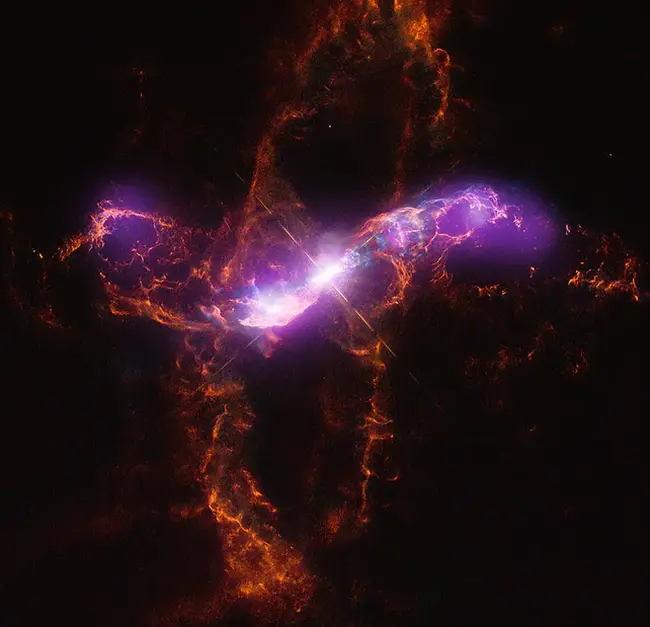
The universe emits light or energy in many different forms. This object is, in fact, a pair: a white dwarf star that steadily burns at a relatively cool temperature and a highly variable red giant. As they orbit each other, the white dwarf pulls material from the red giant onto its surface. Over time, enough of this material accumulates and triggers an eruption. Astronomers have seen such outbursts over recent decades. Evidence for much older outbursts is seen in the spectacular structures observed by NASA’s Hubble Space Telescope (red and blue). X-ray data from Chandra (purple) shows how a jet from the white dwarf is striking material surrounding it and creating shock waves, similar to sonic booms from supersonic planes. Image Credit: X-ray: NASA/CXC/SAO; Optical: NASA/STScI, Palomar Observatory, DSS; Radio: NSF/NRAO/VLA; H-Alpha: LCO/IMACS/MMTF (PD)
Facts
The two components of R Aquarii were resolved with the National Radio Astronomy Observatory’s (NRAO) Very Large Array (VLA) in November 1996. They were separated by 55 milliarcseconds.
The variability of R Aquarii was discovered by German astronomer Karl Ludwig Harding in 1810.
The distance of 218 parsecs was derived during VLBI (Very Long Baseline Interferometry) observations with VERA (VLBI Exploration of Radio Astrometry) in Japan from September 2005 to October 2006. The astronomers calculated an expansion age of around 240 years for the inner nebulae around the R Aqr system, indicating that the nebular material was expelled around the year 1773.
Edwin Hubble studied R Aquarii in order to better understand the mechanism behind the eruptions. He proposed that the star had erupted around 600 years ago. Astronomers later realized that the system had undergone more than a single eruption. The latest one was recorded in the late 1970s.
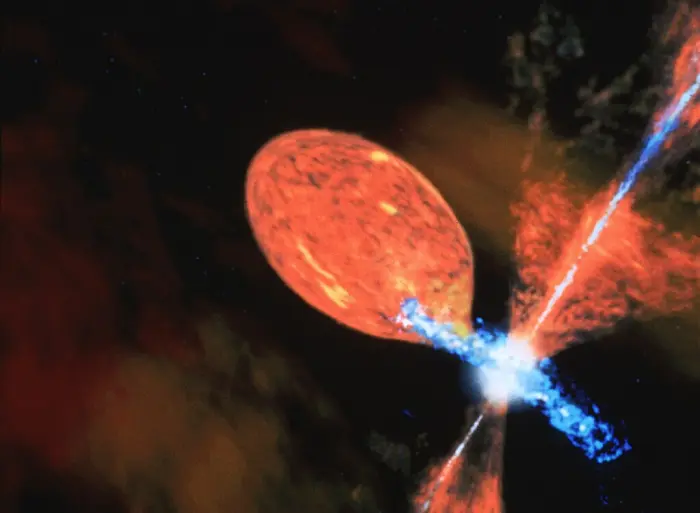
A 3D Rendering of the star R Aquarii, a symbiotic star, during an outburst. Image credit: NASA, ESA, and D. Berry (STScI) (PD)
Name
R Aquarii does not have a proper name formally approved by the International Astronomical Union (IAU). It is most commonly referred to by its variable star designation R Aquarii.
The system is listed as HD 222800 in the Henry Draper Catalogue, HR 8992 in the Yale Catalogue of Bright Stars, HIP 117054 in the Hipparcos Catalogue, and SAO 165849 in the Smithsonian Astrophysical Observatory Star Catalog.
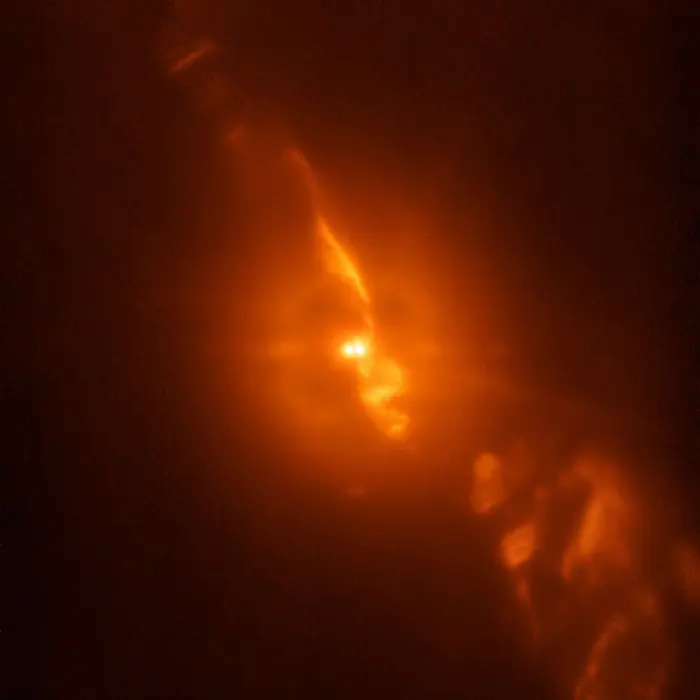
While testing a new subsystem on the SPHERE planet-hunting instrument on ESO’s Very Large telescope, astronomers were able to capture dramatic details of the turbulent stellar relationship in the binary star R Aquarii with unprecedented clarity — even compared to observations from the NASA/ESA Hubble Space Telescope. This image is from the SPHERE/ZIMPOL observations of R Aquarii, and shows the binary star itself, as well as the jets of material spewing from the stellar couple. Image credit: ESO/Schmid et al. (CC BY 4.0)
Location
R Aquarii is located in the southeastern part of Aquarius, north of the imaginary line connecting Skat in Aquarius and Diphda in Cetus. At declination -15° 17’, the star system is visible from most locations on Earth for at least part of the year.
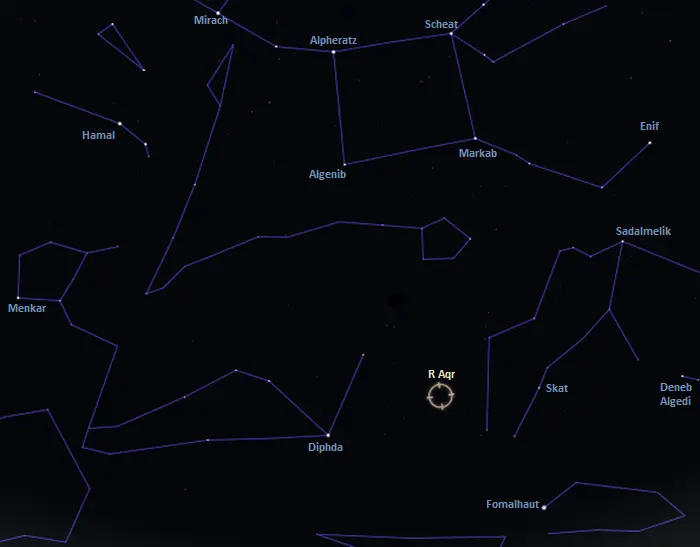
The location of R Aquarii, image: Stellarium
Constellation
R Aquarii lies in the constellation Aquarius. The celestial Water Bearer is one of the 12 zodiac constellations, which lie on the ecliptic (the Sun’s apparent path across the sky). It was catalogued by the Greco-Roman astronomer Claudius Ptolemy with other Greek constellations in the 2nd century CE.
Aquarius stretches across 980 square degrees of the sky on the celestial equator. It is the 10th largest constellation in the sky. Like other equatorial constellations, it is visible from most places on Earth for at least part of the year.
In spite of its size, Aquarius is one of the less conspicuous zodiac constellations. Its brightest stars – the yellow supergiants Sadalsuud (Beta Aquarii) and Sadalmelik (Alpha Aquarii) – shine at third magnitude. They can be found using the bright stars of the Great Square of Pegasus, an asterism that dominates the evening sky during the northern hemisphere autumn.
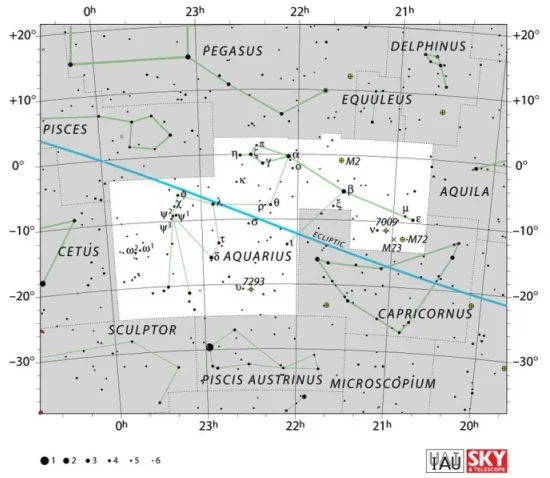
Aquarius constellation map by IAU and Sky&Telescope magazine
Other notable stars in Aquarius include the blue-white main sequence star Skat (Delta Aquarii), the red giant Lambda Aquarii, the binary systems Epsilon Aquarii (Albali), Gamma Aquarii (Sadachbia) and Xi Aquarii (Bunda), the triple star system Zeta Aquarii, the evolved yellow star Ancha (Theta Aquarii), the nearby triple star EZ Aquarii, and the red dwarf TRAPPIST-1, which hosts seven orbiting exoplanets.
Deep sky objects in Aquarius include the bright planetary nebulae known as the Helix Nebula (NGC 7293) and the Saturn Nebula (NGC 7009), the globular star clusters Messier 2 and Messier 72, and the peculiar galaxies NGC 7252 (the Atoms for Peace Galaxy) and NGC 7727.
The best time of the year to observe the stars and deep sky objects in Aquarius is during the month of October, when the constellation appears higher above the horizon in the early evening. The entire constellation is visible from locations between the latitudes 65° N and 90° S.
The 10 brightest stars in Aquarius are Sadalsuud (Beta Aqr, mag. 2.87), Sadalmelik (Alpha Aqr, mag. 2.942), Skat (Delta Aqr, mag. 3.28), Zeta Aquarii (mag. 3.65), 88 Aquarii (mag. 3.679), Lambda Aquarii (mag. 3.722), Albali (Epsilon Aqr, mag. 3.77), Sadachbia (Gamma Aqr, mag. 3.849), 98 Aquarii (mag. 3.97), and Eta Aquarii (mag. 4.04).
R Aquarii
| Spectral class | M5e-M8.5e + pec |
| Variable type | Mira and Z Andromedae |
| U-B colour index | −0.62 |
| B-V colour index | +1.98 |
| Apparent magnitude | 5.2 – 12.4 |
| Distance | 711 light-years (675 – 750 ly); 218 parsecs (207 – 230 pc) |
| Parallax | 4.59 ± 0.24 mas |
| Radial velocity | −22.0 ± 0.9 km/s |
| Proper motion | RA: +40.587 ± 0.227 mas/yr |
| Dec.: −30.411 ± 0.183 mas/yr | |
| Constellation | Aquarius |
| Right ascension | 23h 43m 49.4634303216s |
| Declination | −15° 17′ 04.176349872″ |
| Names and designations | R Aquarii, HD 222800, HR 8992, HIP 117054, SAO 165849, BD−16°6352, GC 32948, GCRV 14862, PLX 5744.01, PPM 242022, GSC 06404-00077, TIC 92138849, AAVSO 2338-15, SKY# 44830, IRAS 23412-1533, 2MASS J23434939-1517043, AKARI-IRC-V1 J2343494-151703, ASAS J234349-1517.1, ASASSN-V J234349.63-151703.1, WEB 20637, EM* MWC 400, GEN# +1.00222800, IRC -20642, RAFGL 3136, 1RXS J234351.0-151655, [WCP90] 234114.252-153343.26, SBC9 1454, UCAC2 26363725, UCAC4 374-180350, YZ 105 8733, WISE J234349.55-151705.1, WISEA J234349.53-151704.8, 2XMM J234349.7-151700, TYC 6404-77-1, Gaia DR2 2419576358847019136, Gaia DR3 2419576358847950592 |
R Aquarii A
| Mass | 1 – 1.5 M☉ |
| Luminosity | 4,780 L☉ |
| Radius | 430 R☉ |
| Temperature | 2,800 K |
| Surface gravity | -0.5 cgs |
R Aquarii B
| Mass | 0.6 – 1 M☉ |
| Luminosity | 5 – 20 L☉ |
| Radius | >0.1 R☉ |
| Temperature | 60,000 K |